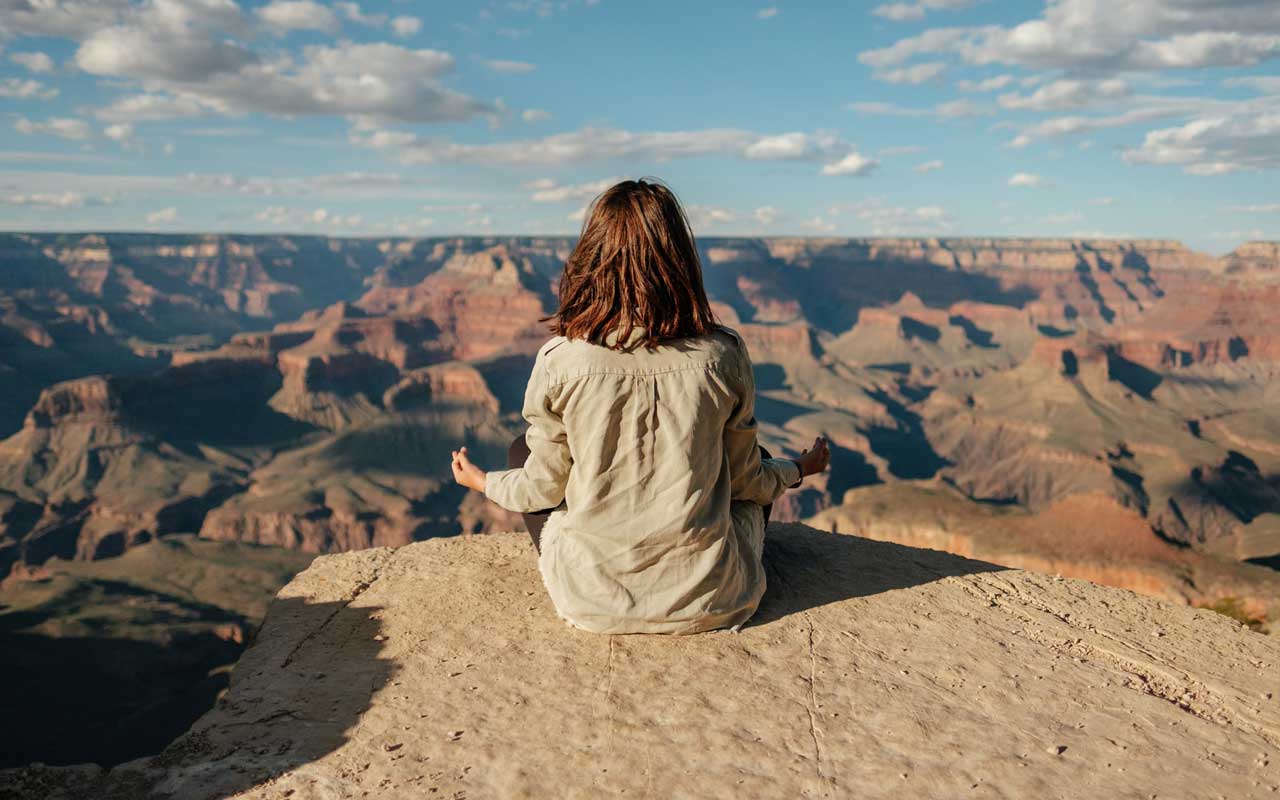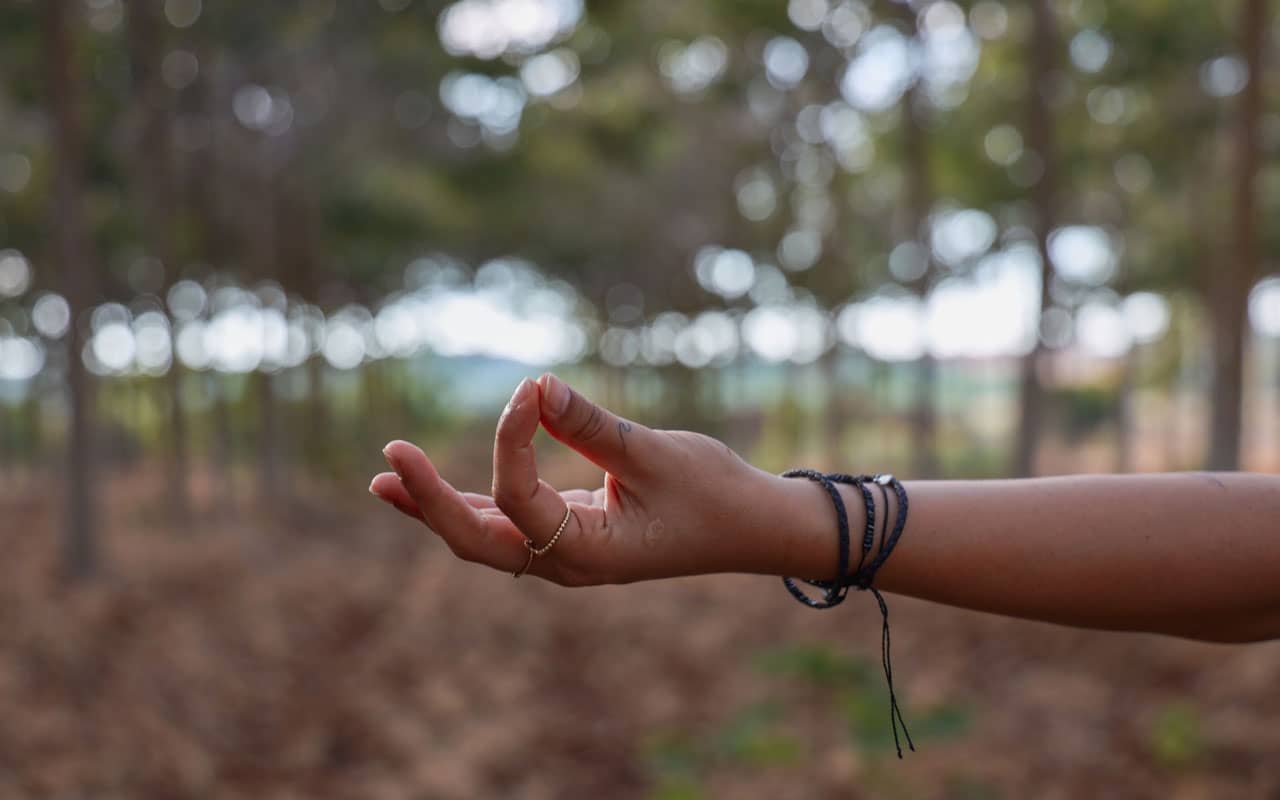Podcast: Download
Subscribe: Apple Podcasts | RSS
 You’ve experienced obstacles in your visualization meditation practice, right?
You’ve experienced obstacles in your visualization meditation practice, right?
I sure have, but I persisted and eventually found ways to break through all my blocks. But without any practical guidance, my progress took far longer than necessary.
That’s why on this page, I’m going to share my best tips for visual meditation.
The exact way to make substantial progress may surprise you.
Here’s what this post will cover:
What is Visualization?
5 Incredible Benefits of Visualization
4 Steps to Visualizing Through Meditation
Meditation and Visualization, Simplified
What is Visualization?
We usually think visualization is about mental pictures.
It is, but that’s just scraping the surface. And stopping at the visual level is why so many people get stuck.
For example, did you know there’s something called aphantasia? It means not having a mind’s eye.
I’ve been in this world, and yet I could still visualize while meditating.
How?
By using a full range of “Magnetic Modes” to experience multisensory visualization.
We’ll talk about these visualization modes below. But for now, it’s important to consider what we get from going past pictures to multisensory visuals.
5 Incredible Benefits of Visualization
There are a handful of important benefits a visual meditation practice brings.
1. Digital Fasting Boosts Memory
Time away from devices creates mental focus, boosts concentration and extends attention span
A lot of people look for visualization apps. In many cases, that’s going to be counterproductive. Instead, you get more benefits from leaving all the devices behind. I call this Digital Fasting.
I try to get in at least one per day. Personally, I go to the local campus, sit on a bench, close my eyes, and visualize.
By spending time visualizing with full knowledge that nothing will interrupt you, you’ll not only improve your mental imagery skills. You’ll also expand your attention span.
Plus, the walking back and forth from your chosen meditation area gives you exercise and encourages diffuse thinking.
As Alex Pang notes in his book Rest: Why You Get More Done When You Work Less, many of the most productive authors and inventors visualized while walking. It was the walking itself that helped them come up with so many great ideas.
2. Creative Problem Solving
When you visualize in a multi-sensory way, you practice what you can think of as “mental rotation.” You literally spin a problem around in your mind so you can see it from multiple angles.
In the 13th century, Ramon Llull created a process called ars combinatoria that used visualization as a kind of mental machine. Not much is known about it, but one aspect seems to have involved thinking through a series of metrics.
For example, you would think about how much something weighed, its length, width, color, and other aspects. Merely running through these characteristics helps the mind consider problems in a way that is not possible without multi-dimensional visualization.
The 40 Triz Principles are a related, modern manifestation of this approach to visualization. You might look at something like this and ask, “What the heck does this have to do with meditation?”
Please revisit point one and think of all the problems that people solved when they went back to first principles about certain problems and took a walk to “rotate” the various dimensions in their minds.
3. Encourages Deep Relaxation
So long as you don’t place pressure on yourself, the benefits of visualization will shine clear on their own.
But if you find yourself unable to ease into it without expecting a particular outcome, you can start by visualizing yourself as relaxed. You can imagine your own body using multi-sensory tools and then imagine each part relaxing.
For example, you can visualize a warm blanket easing all the muscles in your feet, then your calves, thighs, lower back, etc.
And by using a visualization of relaxing yourself, you get to meditate and practice meditative visualization at the same time!
4. Visualization Combats Negativity
As I shared in my TEDx Talk, I think of negative thoughts in terms of the “like/dislike monster.”
Sure, that ancient image is a bit silly. But that’s the point. Visualizing attachments as a kind of dragon-like monster instantly helps me neutralize unwanted thoughts.
In other words, you can use positive thoughts to get rid of unwanted ones through visualization.
5. Provides Emotional Stability
When you practice visualization consistently, you have mental images you can revisit on demand. The more you practice, the more tangible they will be for you, leading to great mental strength.
For example, when I went to defend my Ph.D. dissertation, I relaxed by mentally visiting my favorite bench near Lake Ontario.
Although I was sitting outside the examination room in the Vanier College building of York University and should have been shaking in my boots, I wasn’t.
Instead, I had my bike on its kickstand and was laying on the bench beneath a warm summer sun. I could hear the water lapping at the shore and felt a light breeze.
It was bliss in the midst of a nervous moment and I took that emotional stability with me into the examination room. After the committee grilled me for two hours, the head examiner told me, “The only guy cooler than you is Miles Davis!”
I told him that I really owe it all to the guided visualization meditation that I created for myself. And you can learn how to do it yourself quickly and easily.
4 Steps to Visualizing Through Meditation
There are 4 steps to take on your journey to guided visualization.
1. Learn About Multi-Sensory Visualization
Remember this code: KAVE COGS.
I use this simple to remember acronym to help me go through my visualizations in a structured way.
- Kinesthetic
- Auditory
- Visual
- Emotional
- Conceptual
- Olfactory
- Gustatory
- Spatial
It’s a lot like ars combinatoria applied to meditation. For example, I gave you a sense of it with my Lake Ontario meditation.
I feel the physical sensation in my imagination of the wind and warmth from the sun.
I hear the waves.
I don’t see much in my imagination, but I still get something like a mental picture of the sun and the blue sky.
Then I make sure to remember calm and peaceful emotions visiting the lake in Toronto always made me feel in my heart and mind.
Using concepts is a bit trickier to explain, but one of the simplest is the fact that it’s Lake Ontario, not some other body of water. It’s also in Toronto, a place where I have lots of history.
Next, I think of the taste of water from the water bottle I used to always have bolted to my bike.
I smell the water and finally think of the spatial elements.
I’m talking about the length of the bench. How thick the wood was and how heavy it must have been.
It might sound silly, but it’s actually the path to deepening the experience of the visualization meditation.
Finally, I sometimes add spatial factors like how long it took to ride my bike to the lake and how far away the CN Tower appears in the distance.
All of these factors combined really pay off when you practice them consistently and as a package.
2. Have a Regular Meditation Spot and Time of Day
I’ve already mentioned my current favorite meditation area. There’s good reason to believe that visiting the same places to meditate “anchors” your practice.
By this, I mean it’s a lot easier to settle in quickly by conditioning your mind to fall into the practice when you ritualize the location.
Ultimately, you want to be able to meditate anywhere, but it’s an ability you’ll sooner develop in bulletproof fashion by keeping a regular time and place than if you constantly randomize everything.
As they say, failure to plan is planning to fail. There’s great wisdom in that when it comes to getting the most out of relaxation visualization in particular.
In my own practice, I don’t get out of bed in the morning without visualizing first. That makes it less critical when exactly I go outside to walk and meditate. But I still try to make sure it’s before noon to keep a regular pattern.
3. Pick an Object or Text
Franz Bardon describes a powerful object-based meditation in Initiation Into Hermetics. Basically, you picture a clock on a wall.
The goal is to hold that clock in your mind as sharply as possible for as long as you can, working up to 20 minutes or more.
Personally, I don’t think it’s strictly necessary to go that long. Even 2-5 minutes will do. It doesn’t have to be a clock either — especially since such an object involves movement and sound (if it ticks). You can imagine a vase, bookcase, or a toy you had as a child.
Or, my favorite is to use passage meditation. I’ve memorized long-form texts and simply start at the beginning and don’t stop mentally reciting them until I’m done. Currently, I recite four pieces and it takes about forty minutes.
Sometimes I recite them out loud, but usually I just do it in silence. I use a Memory Palace, which provides the ultimate visualization meditation because I revisit each and every part of the mental journey where I laid out the words.
Here’s the Memory Palace journey for one of them:
There’s a powerful and streamlined process anyone can follow to get a Memory Palace working for long-form passage meditation.
Another option is to memorize something like the planets and reflect on their position in space for visualization meditations. Alexander Dicsone advocated this practice, something Martin Faulks has recently revived in The Hermetic Art of Memory.
Of course, you don’t have to tie your visualization practice to esoteric matters.
Even creating an image of Einstein writing E=MC2 on a chalkboard can provide a powerful meditation that offers all of the benefits of above. After all, I’m a scientist myself and don’t for a second want to live without mental imagery that helps create emotional stability and adds stamina to my focus.
4. Journal Your Experience
I find that keeping a journal is one of the best ways to learn more about meditation and how to deepen it.
Although you certainly can memorize everything about your experiences, I feel it’s best to leave memory free for language learning, names, and other knowledge-based projects.
When you journal, you can write out your KAVE COGS and reflect on any ideas or emotions that come up. This is a great way to visualize, even if you have aphantasia.
Just the other day, I was meditating in the morning and suddenly a vibrant experience of snow sledding with my dad and brother came up. I made sure to write it down in my 5-year snapshot journal.
That way, I’ll not only remember it, but it will come back to me in my handwriting a year later on autopilot. And all without needing an app to remind me.
Meditation and Visualization, Simplified
After all, isn’t that the goal of a proper visual meditation practice? To have your mind work well without getting ensnared in the world of notifications?
I don’t know about you, but I usually find that apps and notifications break my mental imagery, not build it up. Proper guided visualization is something you engineer for yourself.
So what do you say? Do you have any steps or resources to add? Or are you just ready to dive in and start visualizing while you meditate?
And if you want to learn how to use a Memory Palace to make it part of your visualization meditation, sign up for the free training today.
Related Posts
- Memory Athlete Braden Adams On The Benefits Of Memory Competition
Braden Adams is one of the most impressive memory athletes of recent times. Learn to…
- How to Memorize Something Fast: 5 Simple And PROVEN Memory Techniques
Wondering how to memorize things fast? Read this post for 5 solid steps you can…
- Memory Athlete Braden Adams On The Benefits Of Memory Competition
Braden Adams is one of the most impressive memory athletes of recent times. Learn to…














2 Responses
This was dense! I’ve listened twice already. There is a lot here on which I can meditate and about which I want to research more. I really appreciate having found you on the internet. You enrich the lives of so many of us with the way you make complex ideas so accessible. Thank you muchly.
Thanks for checking this one out, Peggy. Please do stop by again and let us know what your research reveals, as well as your practice.
Thanks too for your kind words and for being so supportive with your comments over the years. It helps make these new teachings possible. 🙂